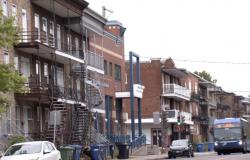A senior citizen was fatally struck by an SUV while crossing a busy intersection because she found herself in a blind spot created by a windshield pillar, a cause that is too little known, but which nevertheless concerns a third of pedestrian deaths to Montreal.
On a cold day in November, Huguette Brisebois was crossing the street when she was hit by a driver who was turning left, at the intersection of Saint-Denis and Beaubien. The light was green and she was walking safely in the designated pedestrian area.
But the 89-year-old lady unfortunately found herself in the Dodge Journey’s blind spot created by the driver’s side windshield pillar, also called the “A pillar.” She died of severe head trauma.
Huguette Brisebois lost her life after being struck by an SUV while crossing Saint-Denis Street on foot, in November 2022, in the borough of Rosemont–La Petite-Patrie.
Photo Agency QMI, MAXIME DELAND
With her recently released report, coroner Me Laurence Sarrazin wishes to highlight the very existence of this blind spot, which is still too little known. The pillar that supports the roof of a vehicle sometimes hides other users.
In 2022, the SAAQ made changes to the learner driver training guide to highlight this area, following recommendations from other coroners.
“But I would like to continue raising awareness among more experienced drivers, who have not seen this aspect in their driving lessons,” explains M.e Sarrazin.
A more present issue
The figures are alarming. Between 2019 and 2023, one in three pedestrian deaths in the metropolis would involve the blind spot created by the A pillar, according to Montreal police statistics revealed in the coroner’s report.
Because to protect those who take their place on board, vehicles are generally built more safely, and therefore more robust. “This pillar is therefore more imposing than a few years ago,” explains Me Laurence Sarrazin.
“On our roads, there are also always more SUVs – which have a larger blind spot – which can have an influence on the fact that this type of collisions occur more often,” worries Sandrine Cabana-Degani, director General of Piétons Québec.
A false blind spot
The good news is that this is not a real blind spot, explains the director. Very simple, the scanning technique before a turn allows you to check for the presence of pedestrians or cyclists (see information box).
Unlike blind spots on the side of a vehicle, however, drivers are less aware of the importance of this maneuver, deplores Mme Cabana-Degani.
“Regardless of the size of the pillar, it remains the driver’s responsibility to adapt their driving to their vehicle to check its environment,” adds Marc Thompson, director of the Association of Driving Schools of Quebec.
The coroner Me Laurence Sarrazin made two recommendations to the SAAQ: increase awareness among drivers of the dangers of these blind spots and promote the scanning technique. Two campaigns in this direction are also planned for this fall, the Company indicated to Newspaper.
The director of Piétons Québec is delighted with the start of mobilization in the province, but she believes that manufacturers also have work to do in the design of vehicles in order to reduce risks at the source.
The sweeping technique
Front windshield pillars can create a blind spot. Pedestrians or cyclists can therefore be invisible to a driver, particularly when turning. The sweeping technique is an effective way to prevent this type of accident.
PHOTO PROVIDED BY THE SAAQ
“It’s simply rocking forward and backward in your seat to clear the blind spot. It’s something that we should all integrate as drivers,” explains coroner Me Laurence Sarrazin.
Do you have any information to share with us about this story?
Write to us at or call us directly at 1 800-63SCOOP.







